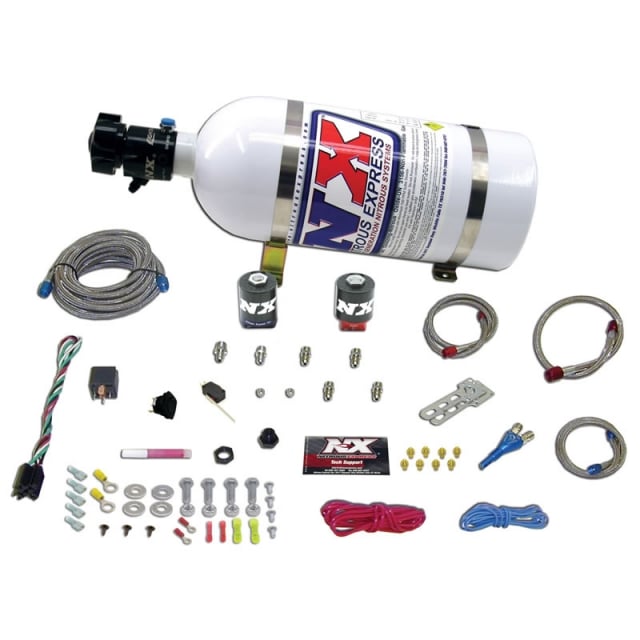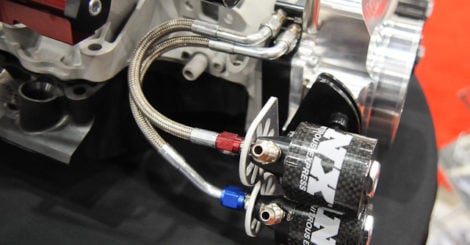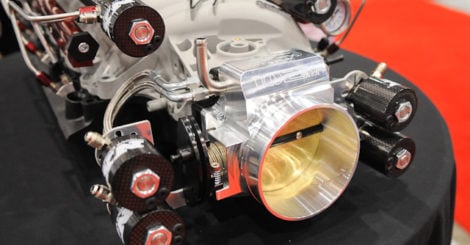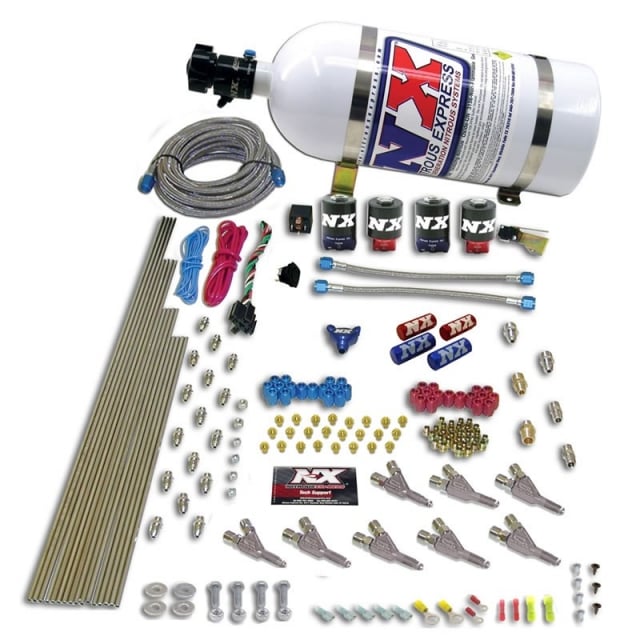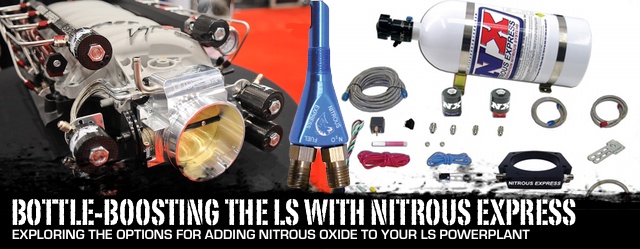 Since its inception, the LS engine family has proven to be robust, trustworthy, and mod-friendly for everything from old-school hotrodder naturally-aspirated builds to crazy twin-turbo setups delivering four-digit horsepower to the tires of street-driven Camaros and Corvettes. But when it comes to adding some extra muscle to your favorite LS, one of the most popular choices is nitrous oxide, thanks to how inexpensive and effective it can be.
Since its inception, the LS engine family has proven to be robust, trustworthy, and mod-friendly for everything from old-school hotrodder naturally-aspirated builds to crazy twin-turbo setups delivering four-digit horsepower to the tires of street-driven Camaros and Corvettes. But when it comes to adding some extra muscle to your favorite LS, one of the most popular choices is nitrous oxide, thanks to how inexpensive and effective it can be.
Nitrous is pretty easy to install and use. Everything has its horsepower limit, but nitrous isn’t pumping heat into the intake like a turbo or supercharger – it’s usually taking heat out of the intake. – Ryan Lewis, NX
You’d be hard-pressed to find a company with more options for adding nitrous to an LS engine than Nitrous Express, or simply NX as it’s known to their fans. Founded in 1996, and still owned and operated by Mike Wood, the company takes great pride in the quality, engineering, safety, and power of their systems – as a matter of fact, Wood makes a point of calling them that, rather than “kits”, because a “system” is something that you install and use as it was designed, rather than hardware that has to be tinkered with.
That philosophy is clearly visible when you look at their offerings for LS applications, and to take us through all the possibilities, we enlisted the help of NX’s Ryan Lewis. What follows is your guide to successfully bottle-feeding your LS, from a mild 35-shot up to a monster multi-stage setup.
In on the Ground Floor
For simplicity, easy installation, and low initial cost, the NX Proton and Proton Plus are the way to go for those new to nitrous oxide, or just looking for a reasonable boost in power to an otherwise stock engine. While the Proton is the clear price leader in the NX lineup with a list price of under $400 for the complete system, per Lewis, “The Proton Plus is what we normally recommend. It has the full throttle switch and the high-flow bottle valve. You can jet that to 150, where the regular Proton only goes to 75.” The Proton systems integrate both fuel and nitrous solenoids into a single compact housing that makes installation easy, and utilize the company’s Piranha and Shark nozzles, respectively.
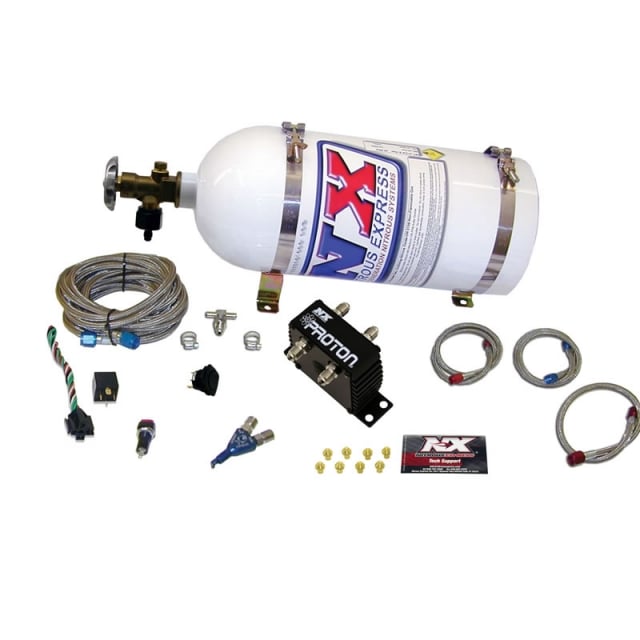 Proton Series Nitrous System PN 20420-10
Proton Series Nitrous System PN 20420-10
- Includes jetting for 35, 50 and 75 horsepower
- 10-pound capacity nitrous bottle with standard bottle valve
- Single Piranha nozzle
- Also available with 5- and 15-pound capacity bottles
The Piranha nozzle (left) offers a very small profile exposed to the airstream inside the intake tract, while the Shark has a higher ultimate flow capability.
Proton Plus Nitrous System PN 20422-10
- Includes jetting for 35, 50, 75, 100, 125, and 150 horsepower
- Can flow up to 250 horsepower with the optional SHO jet kit
- 10-pound capacity nitrous bottle with a high flow billet aluminum Lightning 45 bottle valve
- Single Shark nozzle
- TPS Autolearn wide open throttle module
- Also available with 5- and 15-pound capacity bottles
While the Proton family of systems offers the advantages of compact design and ultimate ease of installation, stepping up to what you might call a “traditional” single nozzle system for your LS opens up more possibilities. Per Lewis, “We have another single nozzle system that would be the next level up that has the ability to go up to 250, and includes billet aluminum and carbon fiber solenoids. That lets you make more horsepower on the same amount of nitrous due to the improved flow pattern through the solenoids.”
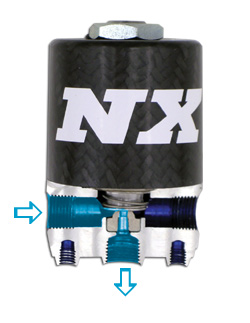
While you’ll often see orifice size mentioned in solenoid specs, the flow path is also important – fewer changes in direction mean more volume and less turbulence.
NX Stage 1 EFI nitrous system PN 20920-10
- Includes jetting for 35HP, 50HP, 75HP, 100HP, 125HP and 150HP
- Can flow up to 250HP with the optional SHO jet kit
- 10-pound capacity nitrous bottle with a high flow billet aluminum Lightning 45 bottle valve
- Single Shark nozzle
- Also available with 5- and 15-pound capacity bottles
Speaking of solenoids, Lewis points out that not all are created equal. “Ours are aluminum, so they’re lighter-weight. Other companies will do CNC to their stainless steel bodies to try to cut down weight, but ours still weigh less,” he explains. Beyond materials used, solenoid design also plays a role in how well the system performs.
“A lot of people have bottom-exit solenoids now, but our flow path is just one 90 degree turn instead of having to make a lot of twists before it exits out the bottom,” Lewis continues. “We’re also unique in that we make our own nitrous solenoids, where some other companies use the same kind of solenoid you’d find delivering CO2 in a Pepsi machine. You won’t see a Nitrous Express billet aluminum and carbon fiber solenoid anywhere but on a Nitrous Express system.”
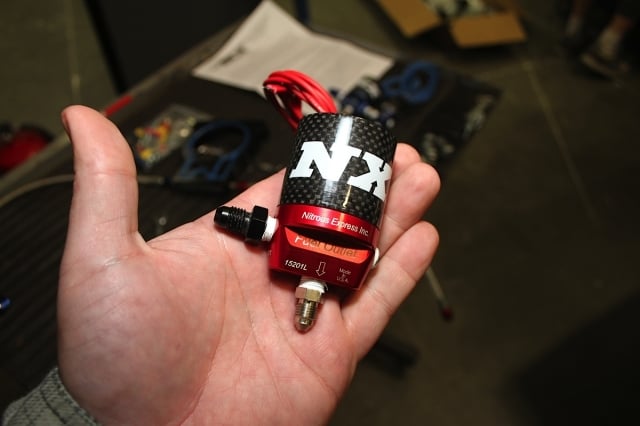
Lightweight yet strong carbon fiber and billet aluminum construction makes NX’s solenoids stand out.
Single nozzle systems also give a great deal of flexibility in installation – basically, the nozzle can go anywhere in the intake tract before it splits into the individual runners for each cylinder, though Lewis advises that there are a few good rules of thumb to follow. “The further away you can get it from the intake valve, the better the atomization process,” he explains. “18-24 inches away from the throttle body will be your best-performing placement.” That distance allows for the nitrous oxide and fuel to thoroughly mingle with each other, and the incoming atmosphere. Better distribution between cylinders, and an increased charge-cooling effect are the results.
Blue Black Plate Special
Right now, the current trend in nitrous systems for EFI applications are plate systems that introduce N2O and fuel through a “spacer” inserted between the throttle body and the intake manifold inlet. While plates have been around since forever for carbed engines, today’s EFI plates generally dispense with the spraybar typical of those older systems in favor of some sort of perimeter orifice design that leaves the intake tract unobstructed. “90mm plates are number one – we sell more of them than anything else,” Lewis claims.
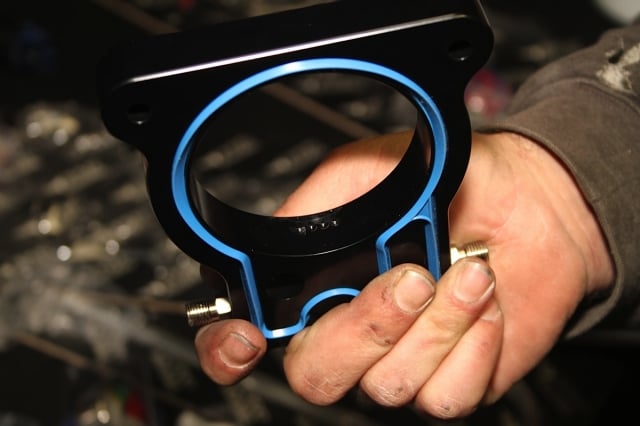
NX’s plate-style systems introduce fuel and nitrous oxide through machined passages in a plate that sandwiches between the throttle body and the intake manifold.
He adds, “Plates are great for ease of installation, and they’re easy to hide, especially if you have an engine cover on top of them. You can flow more through a plate than you can a single nozzle – our [single nozzle] systems come with a Shark nozzle, which will flow up to 250, and our LS1 plates flow up to 350, while the LS2 and LS3 plate will flow 400. There aren’t a whole lot of people who are doing it, but it can be done. I know some of our dealers are spraying that much through a plate on their shop cars.”
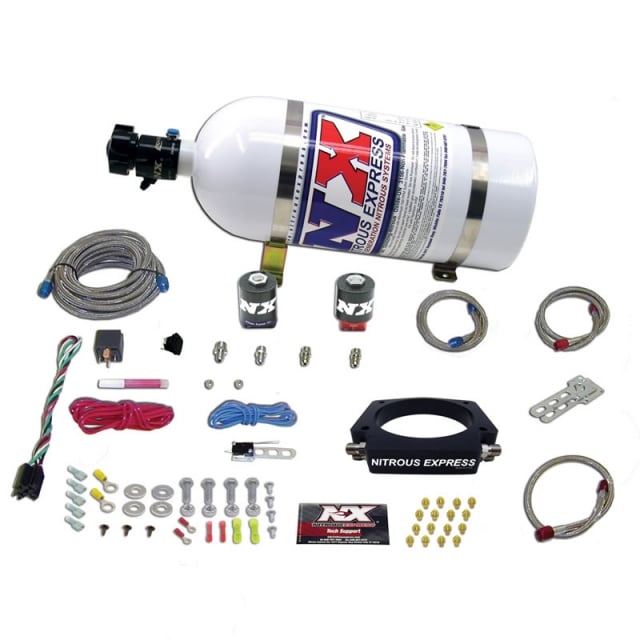 NX LS 3-Bolt Plate System PN 20935-10
NX LS 3-Bolt Plate System PN 20935-10
- Fits 1997-2004 Corvette, 1998-02 V8 Camaro/Firebird, 2004 GTO, as well as 1999-06 GM Trucks with 4.8L, 5.3L & 6.0L engines
- 78mm billet plate
- Includes jetting for 50, 100, 150, 200, 250, 300 and 350 horsepower
- 10-pound capacity nitrous bottle with a high flow billet aluminum Lightning 45 bottle valve
- Also available with 5- and 15-pound capacity bottles
NX LS 90mm Plate System PN 20934-10
- 90mm billet plate fits all stock-diameter 4-bolt LS intake manifolds
- Includes jetting for 50, 100, 150, 200, 250, 300, 350 and 400 horsepower
- Upgrade to a dual stage system by adding PN NX933D
- 10-pound capacity nitrous bottle with a high flow billet aluminum Lightning 45 bottle valve
- Also available with 5- and 15-pound capacity bottles
NX LS 102mm Plate System PN 20933-10
- 102mm billet plate fits all stock-diameter 4-bolt LS intake manifolds
- Includes jetting for 50, 100, 150, 200, 250, 300, 350 and 400 horsepower
- Upgrade to a dual stage system by adding PN NX933D
- 10-pound capacity nitrous bottle with a high flow billet aluminum Lightning 45 bottle valve
- Also available with 5- and 15-pound capacity bottles
There are pros and cons to plates versus a single nozzle system; Lewis admits, “Everybody wants nitrous plates behind the throttle body – that’s the new thing, and the reason we make them. But 9 times out of 10, you will see more horsepower out of a single nozzle system in front of the throttle body than with a plate, for a given jet combo.” But on the up-side, “The plates kind of act like a throttle body spacer as well, because they sit between the throttle blades and the intake manifold, and that might give you a slight increase in bottom end power because of the effective increase in plenum volume.”
The NX 90 and 102mm four-bolt plates have built-in two stage capability, and when combined with a third direct port stage, make for a very potent way to deliver a lot of nitrous oxide in precisely measured doses.
One indisputable advantage to NX’s four-bolt plate systems is how dead-simple they make adding a second stage. “The LS2/3 102mm plate is actually dual-stage, so you can run two stages through the plate, and a third via direct port,” says Lewis. “We have one of our sponsored guys who does that. And we have a lot of customers who will run a small stage off the plate to get them off the line, 150 horsepower, and then bring their main stage on with a direct port system.”
Another Way to Spray
For those looking for straightforward installation, NX has another good option in the form of their MAF systems. Like the plates, these setups don’t obstruct the intake tract, and offer some of the same advantages of a single nozzle system when it comes to placement. “The MAF systems work really good,” Lewis claims. “They’re a bit more expensive than the plates, but they work by kind of the same principle, and like the single nozzle, the further you can get them away from the combustion chamber, the better they work in atomizing the fuel and nitrous.”
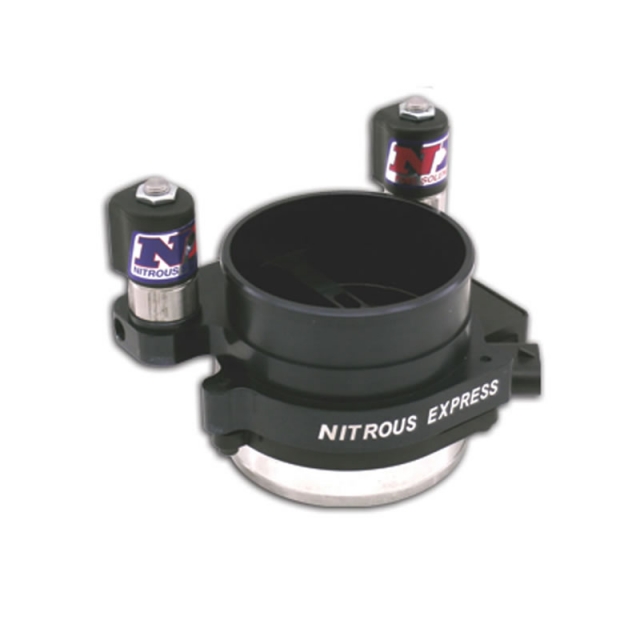 NX 1-Piece MAF System PN 20110-10
NX 1-Piece MAF System PN 20110-10
- For LS1 and LS2 engines with a one-piece MAF housing
- Solenoid mounts are integrated into the housing
- Includes jetting for 35-200 horsepower
- 10-pound capacity nitrous bottle with a high flow billet aluminum Lightning 45 bottle valve
- Also available with 5- and 15-pound capacity bottles
NX 2-Piece MAF System PN 20109-10
- Replaces the factory MAF sensor housings on LT-1 and LS1 with two-piece MAF housing
- Includes jetting for 35-150 horsepower
- Optional 2-stage capability
- Each stage can support up to 250 horsepower with additional jetting
- 10-pound capacity nitrous bottle with a high flow billet aluminum Lightning 45 bottle valve
- Also available with 5- and 15-pound capacity bottles
Eight Times the Fun
A direct port system will come on softer, so you can leave the line without shaking the tires so bad. – Ryan Lewis
At the top of the nitrous food chain are direct port systems; as the name implies, they use an individual nozzle for each cylinder, placed close to the intake port. While they’re the most difficult to install, they offer advantages not found in other designs. “Especially in higher horsepower applications, that’s where direct port really shines,” says Lewis. “Over 300 horsepower on nitrous and above is where I’d recommend it.”
For drag racers in classes that don’t allow multiple stages, or progressive nitrous control, direct port offers what might be a race-winning advantage – per Lewis, “A direct port system will come on softer, so you can leave the line without shaking the tires so bad.” Direct port also allows a high level of control, with Lewis adding, “You can tune each individual cylinder if you need to. You don’t have to rely on the intake to distribute things evenly. If you have a lean cylinder – like on an LS1, the #7 cylinder often goes lean in turbo applications – you can tune for that with a direct port system, where you can’t with a single nozzle or a plate.”
NX LS1 Pro Piranha Direct Port System PN 80010-10
- Eight Piranha nozzles
- Adjustable from 50-300 horsepower
- 10-pound capacity nitrous bottle with a high flow billet aluminum Lightning 45 bottle valve
- Also available with 5- and 15-pound capacity bottles
NX NXL Integrated Rail Technology with Piranha Nozzles PN 20220
- Eight Piranha nozzles
- Entire nitrous system is self-contained in the high-flow fuel rail
- 10-pound capacity nitrous bottle with a high flow billet aluminum Lightning 45 bottle valve
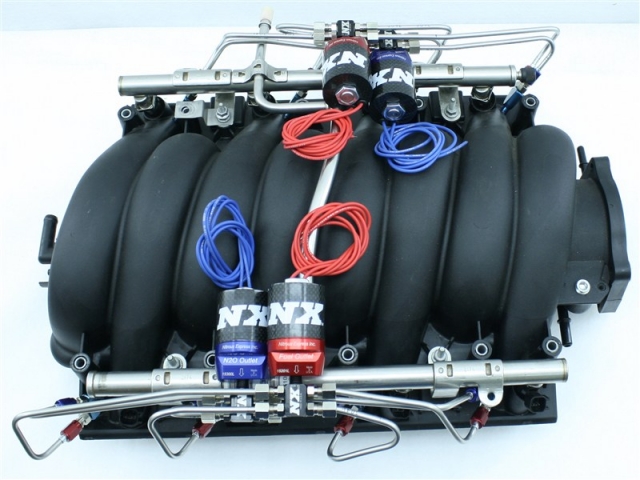 NX 8 Cylinder Vortech Direct Port System PN 80016-10
NX 8 Cylinder Vortech Direct Port System PN 80016-10
- Eight stainless steel Vortech nozzles
- Four Lightning Series solenoids
- Jetting from 200-500 horsepower
- 10-pound capacity nitrous bottle with a high flow billet aluminum Lightning 45 bottle valve
- Also available with 15-pound capacity bottle
Knowing Your Limits
When supplied by a properly-engineered system, correctly installed on a mechanically healthy engine, nitrous oxide is a safe and economical way to add horsepower. But like anything else in life, you have to know your limits. “Nitrous is pretty easy to install and use,” says Lewis. “Everything has its horsepower limit, but nitrous isn’t pumping heat into the intake like a turbo or supercharger – it’s usually taking heat out of the intake. It comes out of the nozzle at -128F, and that’s making denser air by cooling the charge going into the engine, as well as bringing the horsepower coming from the nitrous system.”
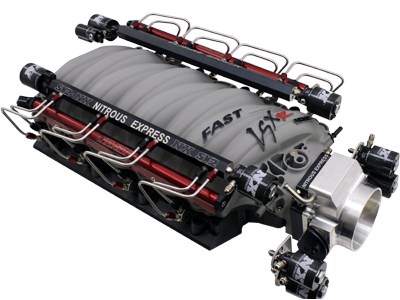 Serious nitrous racers will, of course, put on their big boy pants when it comes to making sure that their engine is up to a regular diet of 300+ horsepower worth of nitrous. But what about the rest of us? Lewis advises, “We’re pretty clear in our instructions – anything over 100 horsepower on an otherwise factory vehicle, we recommend upgrading the fuel pump. And this applies to any way you’re making that power – if you have a cam and bolt-ons, for example. On an LS car, you can normally only add about 100 horsepower before you start dropping fuel pressure, whether that’s through nitrous, polished heads, or whatever.”
Serious nitrous racers will, of course, put on their big boy pants when it comes to making sure that their engine is up to a regular diet of 300+ horsepower worth of nitrous. But what about the rest of us? Lewis advises, “We’re pretty clear in our instructions – anything over 100 horsepower on an otherwise factory vehicle, we recommend upgrading the fuel pump. And this applies to any way you’re making that power – if you have a cam and bolt-ons, for example. On an LS car, you can normally only add about 100 horsepower before you start dropping fuel pressure, whether that’s through nitrous, polished heads, or whatever.”
Besides the fuel supply, once you get past that magic 100-horse mark, ignition timing needs to be addressed as well. “If you’re on a stock vehicle with good fuel, you can run up to 100 horsepower on the stock timing map,” Lewis adds. “Once you get over that, we normally recommend the Lingenfelter retard box or a custom tuning solution.”
Of course, there’s a limit to how much information we can provide in an article like this, but fortunately techs at NX are standing by to answer your questions. As Lewis concludes, “I’d rather have people call 100 times to get the right information than be scared to call.”





